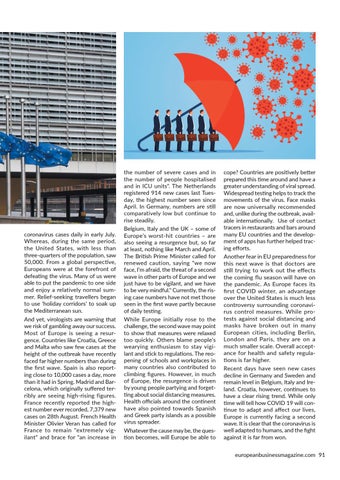coronavirus cases daily in early July. Whereas, during the same period, the United States, with less than three-quarters of the popula on, saw 50,000. From a global perspec ve, Europeans were at the forefront of defea ng the virus. Many of us were able to put the pandemic to one side and enjoy a relatively normal summer. Relief-seeking travellers began to use 'holiday corridors' to soak up the Mediterranean sun. And yet, virologists are warning that we risk of gambling away our success. Most of Europe is seeing a resurgence. Countries like Croa a, Greece and Malta who saw few cases at the height of the outbreak have recently faced far higher numbers than during the first wave. Spain is also reporting close to 10,000 cases a day, more than it had in Spring. Madrid and Barcelona, which originally suffered terribly are seeing high-rising figures. France recently reported the highest number ever recorded, 7,379 new cases on 28th August. French Health Minister Olivier Veran has called for France to remain "extremely vigilant" and brace for "an increase in
the number of severe cases and in the number of people hospitalised and in ICU units". The Netherlands registered 914 new cases last Tuesday, the highest number seen since April. In Germany, numbers are s ll comparatively low but continue to rise steadily. Belgium, Italy and the UK – some of Europe's worst-hit countries – are also seeing a resurgence but, so far at least, nothing like March and April. The Bri sh Prime Minister called for renewed caution, saying "we now face, I'm afraid, the threat of a second wave in other parts of Europe and we just have to be vigilant, and we have to be very mindful." Currently, the rising case numbers have not met those seen in the first wave partly because of daily tes ng. While Europe initially rose to the challenge, the second wave may point to show that measures were relaxed too quickly. Others blame people's wearying enthusiasm to stay vigilant and s ck to regula ons. The reopening of schools and workplaces in many countries also contributed to climbing figures. However, in much of Europe, the resurgence is driven by young people partying and forgetng about social distancing measures. Health officials around the con nent have also pointed towards Spanish and Greek party islands as a possible virus spreader. Whatever the cause may be, the queson becomes, will Europe be able to
cope? Countries are posi vely be er prepared this me around and have a greater understanding of viral spread. Widespread tes ng helps to track the movements of the virus. Face masks are now universally recommended and, unlike during the outbreak, available interna onally. Use of contact tracers in restaurants and bars around many EU countries and the development of apps has further helped tracing efforts. Another fear in EU preparedness for this next wave is that doctors are s ll trying to work out the effects the coming flu season will have on the pandemic. As Europe faces its first COVID winter, an advantage over the United States is much less controversy surrounding coronavirus control measures. While protests against social distancing and masks have broken out in many European cities, including Berlin, London and Paris, they are on a much smaller scale. Overall acceptance for health and safety regulaons is far higher. Recent days have seen new cases decline in Germany and Sweden and remain level in Belgium, Italy and Ireland. Croa a, however, con nues to have a clear rising trend. While only me will tell how COVID 19 will connue to adapt and affect our lives, Europe is currently facing a second wave. It is clear that the coronavirus is well adapted to humans, and the fight against it is far from won. europeanbusinessmagazine.com 91





































